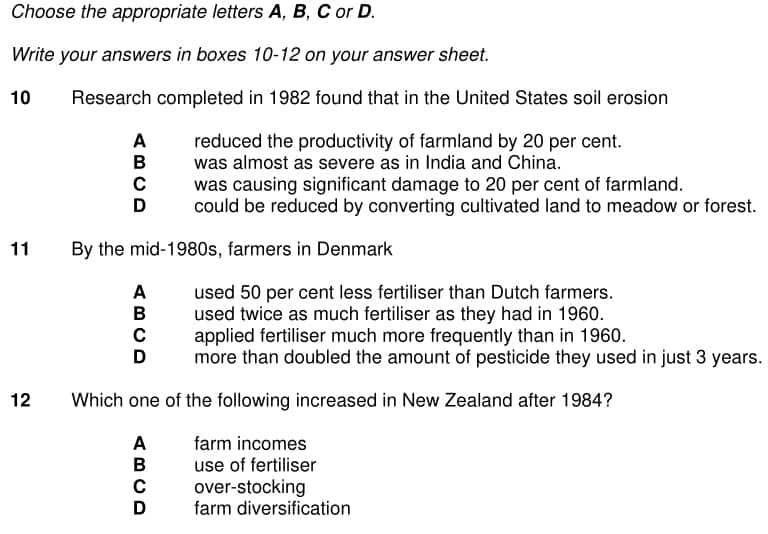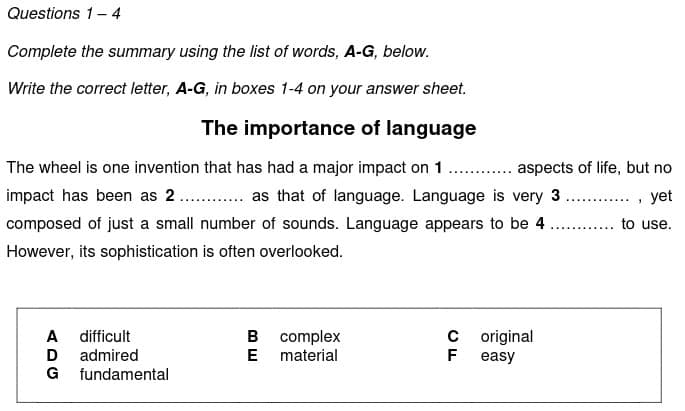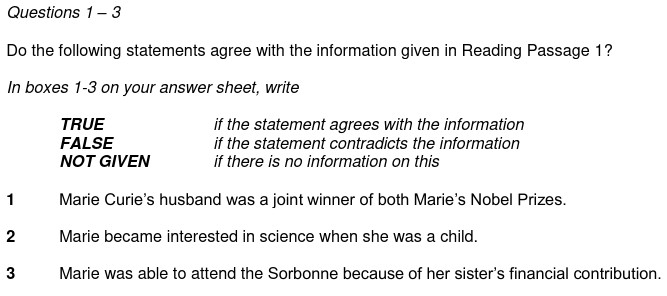IELTS listening and reading are two of the test sections most learners find easier than speaking and writing. You may be one of these learners. Don’t let this feeling stop you from fully preparing for them, however.
It’s still a good idea to understand the expectations and practice for the IELTS reading test. The test expects you to read and understand complex native level material. So you want to be as prepared as possible on your test day.
Here are five things that you can do to prepare for your IELTS reading test:
- Read the Questions First
- Skimming and Scanning
- Understand the Question Types
- Effective Time Management
- Practice
Format
Before we get into the tips, it’s important to understand the format of the reading test. Knowing test format is one of the most important and easily forgettable aspects of studying.
The IELTS reading test is 60 minutes long. Test-takers will be given three passages in English to read. They will come from English language journals, magazines, books, and newspapers. The topics will be of general interest to undergraduate or postgraduate students and professionals seeking registration.
You will need to answer a total of 40 questions during the test. Unlike the listening test, you will not receive extra time to transfer your answers to the answer sheet. Effective time management is very important so that you do not run out of time and are unable to record your answers or proofread your work.
You should take care when writing your answers down. You will lose marks if you make spelling and grammar errors. This is why you need to ensure you have adequate time at the end for proofreading. You don’t want to lose a mark because you were rushing to write down your answers on the sheet. Remember, half marks are not given in IELTS.
What band score do you need?
Before you think about ways to improve your band score, it’s a good idea to understand what you need to achieve for your desired band score. For the reading test, your band score depends on the number of questions you answer correctly.
Each question is either marked right or wrong. There are no half points given in the IELTS test. So you will need to make sure that you write your answers clearly and that you give yourself enough time to proofread your work and double check your answers.
Below is a chart showing the scores you will need for each band score starting at 5 and going to 8.
| Band Score | Score out of 40 |
|---|---|
| 5 | 16 |
| 6 | 23 |
| 7 | 30 |
| 8 | 35 |
Read an Overview of the IELTS Test Here!
1. Read the Questions First
It’s a reading test. So you should start by reading the passage first, right?
No!
This is a common mistake many test-takers make. You do not want to begin by reading the passage; you want to start by reading the questions first. The passage will be dense and full of a lot of extra information you won’t need to answer the questions.
The reading test is only an hour long. During this time, you will have to read and understand three passages and their questions, identify the answers, and write them on your answer sheet. You don’t want to waste time by reading each entire passage if you don’t have to.
The questions will contain hints about how you should answer each of them. You can use these hints to quickly find the information you need in the passages and then use it to answer the questions.
2. Skimming and Scanning
Skim
12 to read, study, consider, etc., something in a superficial or cursory way.
source
Scan
1 to glance at or over or read hastily: to scan a page.
source
Skimming and scanning is a useful technique for timed tests. It involves quickly reading a passage and looking for specific information in it.
This is the reason why you should read the questions first. The questions will have information about what is needed to answer them. Let’s look at an example:

Above are a set of sample IELTS academic reading test questions. This particular set is an example of multiple choice questions. There is a lot of information you can receive just from reading these questions alone.
The first thing you should do is identify the topics of the answers. These will allow you to quickly scan the passage for mentions of these topics, so you can find the most appropriate answer.
What parts of each question do you think you would use to scan the passage? Take a moment to consider this yourself before reading ahead.
Question 10
Question 10 mentions a date and a place. These are the two most important pieces of information you will use to scan the passage.
- 1982
- United States
You can use these to quickly scan the passage and find the answer to the question.
Question 11
This one is a little trickier than question 10. The question asks about the mid-1980s and the country of Denmark.
During the reading test, you will need to keep synonyms in mind when considering correct answers. The phrase “mid-1980s” might be present in the passage, but it also might not be included.
Do you know any other ways to say “mid-1980s”?
Here is a list of things you would want to scan for:
- mid-1980s
- 1985
- Denmark
It’s just as likely that the year 1985 will appear in the passage as the phrase “mid-1980s” will. Keep synonymous ways of expressing information in mind when you think about words to scan for and your answers.
Question 12
Like question 10, this question mentions a specific year and a country. These are the two words you will want to scan for in the passage.
- 1984
- New Zealand
If you identify the topics of each question, you can use them to quickly scan the passage for that information and find the section which contains the answer. This will allow you to skip over large sections of the passage that are irrelevant.
You want to minimize the amount of text you have to read during the test. If you try to read the entire passage, you will run out of time. Start by reading the questions first and identifying the topics of each so you can rapidly pinpoint each section of the text where your answers will be.
If you want to know more about skimming and scanning, check out the video below!
3. Understand the Question Types
There are twelve different question types in the IELTS reading test. Each one will require a different strategy to answer, so it’s important that you understand each question type before you encounter them on the test.
Each question set begins by stating your objective and the proper format for answering the question. You want to make sure that you carefully read this part of the question set. If you answer the questions in an improper way, you will lose points unnecessarily.
Additionally, you should note that most questions are presented in order. This means that the information to answer question 10 will come before the information for question 11, and so on.
This means that if you find the information for question 11 before you answer question 10. You have skimmed too far and need to back up.
Flow-Chart Completion

The flow-chart completion question will require you to fill in a chart using words from the passage.
You can use skimming and scanning here to pinpoint where the answer to the question begins.
In this particular example, you would want to find a part of the passage where ” how caloric-restriction mimetic works” appears. The question is only asking for this information, so all other parts of the passage can be ignored while you answer this question set.
Matching Features

This is another type of question where skimming and scanning are useful. The matching features question set gives you a box of key words which you need to match to ideas given in the questions.
This box of key words will be the words you skim and scan for. This question type makes it very easy to rapidly answer because you don’t need to identify the topic of each question.
You can immediately start skimming for each key word.
Matching Headings

The matching headings question set is one example where skimming and scanning is not effective. In order to match each heading to a paragraph, you will have to read the paragraph. This will take a lot of your time.
This is why it’s important to quickly finish questions where you aren’t required to read the entire passage. A question type like feature matching or multiple choice can be completed swiftly.
This leaves you additional time to tackle questions where you cannot use the skimming and scanning strategy, such as heading matching questions.
The most effective way to approach this question type is to read and understand each heading provided in the box.
If you understand how to do the question, you can skip reading the example section. This frees up some of your time. It will be necessary to read the entire passage to correctly match each heading with each section.
You can keep an eye out for key words in each heading to answer the questions more rapidly, however you don’t want to go too fast and risk making a mistake.
Matching Sentence Endings

Skimming and scanning works well for matching sentence ending question types. However, it will take a little more effort to identify the key words you should be looking for.
The key words will be dependent on the specific questions you’re asked about the passage. Some general things to keep in mind are to look in the passage for the main topic of each sentence. For the question set above this would be:
- Harness’s research method.
- reconstruction & 16th-century London scientific groups
- innovation/innovative
Multiple Choice (one answer)

Multiple choice answers want you to choose the most correct answer for each question. Understand that this is the most correct answer. So you will need to carefully read and understand the passage section to determine which answer fits best for each question.
There may be multiple answers which could be considered correct, but only one of the answers fits best for each question asked. You must carefully read the question and the possible choices to figure out each correct answer.
Skimming and scanning will be useful for multiple choice questions. Look at each question prompt to find the key words to look for in the passage.
Multiple Choice (more than one answer)

This question type is similar to the multiple choice type above, except you will need to choose multiple answers for each question. In some instances, you will need to choose two answers like in the example above. However, some questions will need you to choose three answers.
Ensure you read the question carefully to understand how many answers you need to choose.
As usual, you can find key words to skim for in the text by reading the question.
Note Completion

The note completion question type will require a little more effort to find the key words to scan for.
You should carefully consider the sentences to discover the main topic for each bullet point. However, skimming and scanning works very well for this question type too.
Keep in mind that questions are presented in order. The first question of the set will appear first in the passage and the second will appear after that, and so on. If you are skimming the passage and start to see information related to a following question, you have gone too far and need to back up.
Sentence Completion

For this question type, be careful about the amount of words you need to write. Always consult the question before you write to ensure you are not writing more or less than you need to. You will lose marks if you do not follow the written instructions.
Hyphenated words (e.g. test-taker) count as one word and contractions (e.g. can’t) won’t be tested for. If you need to write a number, you can use a symbol (2) or write the word (two).
Like similar questions, the information is presented in order, so you can find the information you need in the passage in the same order it is presented by the questions.
Summary Completion (words from text)

This type of question is very similar to the one above. You should follow the same guidelines when answering summary completion questions. You will need to pick information from the text for your answers.
Again, you should carefully read the question to understand your instructions. If you include more or less words than you are instructed to, you will lose marks. Avoid this by reading and fully understanding the question first.
Hyphenated words (e.g. test-taker) count as one word and contractions (e.g. can’t) won’t be tested for. If you need to write a number, you can use a symbol (2) or write the word (two).
Unlike sentence completion questions, information may not always be presented in order, so you should carefully read and consider the information in the passage to ensure your answers are correct.
Summary Completion (word box)

This question type is identical to the one above. The only difference is the answers available to you. In the previous question, you had to pick your answers directly from the text. However, for this question type you are given a word bank to choose your answers from.
This simplifies the process for you. Most of the time, there will only be a single word for each choice in the word bank.
Don’t let the easier format fool you. You should still be dedicating your focus to reading and understanding the text so that you can choose the correct answers.
Table Completion

You will need to fill in missing information from a table in this question type. The information you need to answer the question must be extracted from the passage.
As usual, you must read the question carefully. You will lose marks if you write more or less words than you are instructed to.
Hyphenated words (e.g. test-taker) count as one word and contractions (e.g. can’t) won’t be tested for. If you need to write a number, you can use a symbol (2) or write the word (two).
Information you need to answer this question may not always appear in order in the passage. You will need to scan the passage for the key words and then carefully read it while you look for the information you need for your answers.
Identify Information (True/False/Not Given)

This type of question will require more careful reading than other types. You will have to read the passage, similar to the heading matching question type.
It is a variant of the classic “true/false” question type. This type of question also adds the “not given” option for each question. It’s important to understand the difference between “false” and “not given”.
A question is marked “false” when information that contradicts the statement is given in the passage.
A question is marked “not given” when there is no information contained in the passage about that statement.
Don’t rely on previous information that you may know about the topic when you answer this question type. You want to find information that supports your answer in the passage itself. Don’t leave yourself open to a wrong answer needlessly.
4. Effective Time Management
Sixty minutes to read three passages and answer 40 questions isn’t a lot of time. You will need to be able to rapidly read each passage, focus on answering the questions, and leave yourself enough time to fill out your answer sheet and proofread your work.
This is why proper time management is essential to passing with the band score you need.
The maximum amount of time you want to spend on each passage is 20 minutes. However, if you take this much time you might not have adequate time to transfer your answers to the answer sheet and proofread your work. So ideally, you want to complete each section within around 17 minutes. In other words, you want to spend about one minute and twenty seconds completing each question.
5. Practice
Like for all parts of the IELTS test, practice is very important. The reading section of the test is challenging. You should spend time practicing for it.
The academic reading test will use passages from a variety of sources. They will be academic in nature about general interest topics such as history, psychology, biology, etc. This means you should expose yourself to a wide variety of different writing types and styles.
Your preparation for the test shouldn’t only be studying using practice exercises, but you should be reading all types of native English material to prepare yourself for the test. This will expose you to new kinds of vocabulary and styles of writing.
One of the most important techniques for your success with the IELTS reading test will be skimming and scanning. You should hone this skill while doing practice exercises as it will be vital to your success.
IELTS test preparation can be tough. You might not have a lot of experience using techniques such as skimming and scanning while reading English. This can make practicing difficult or overwhelming.
If you would like to receive personalized coaching about IELTS reading or any other part of the test, feel free to contact me here.
Click here to learn more about my IELTS coaching!



